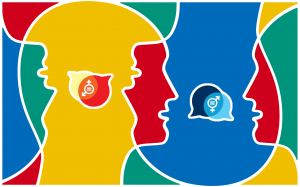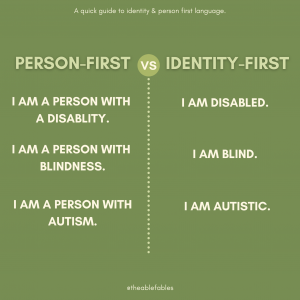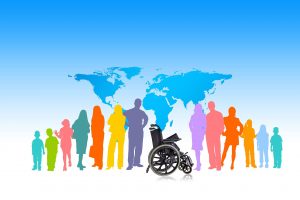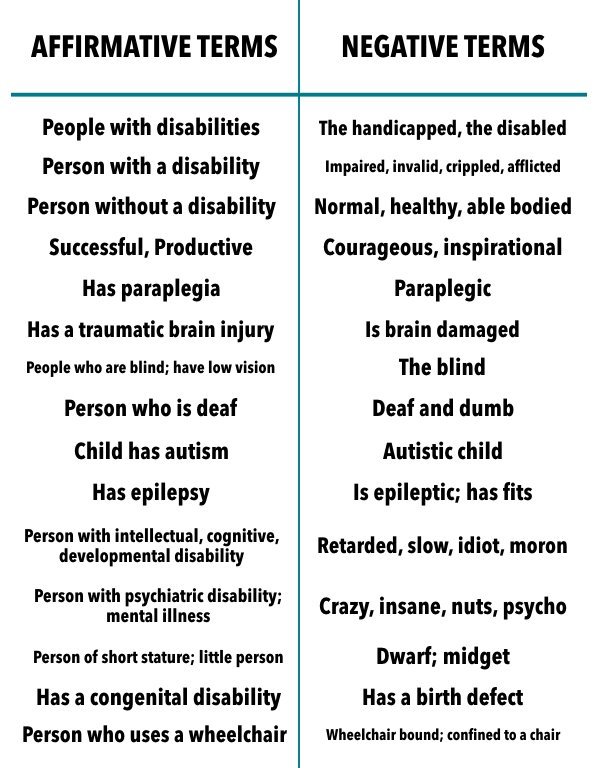3 Using Inclusive Language
Learning Objectives
- What is inclusive language ?
- Why is inclusive language important ?
- What is implicit bias and how does it affect inclusive language?
- Guiding principles for creating more inclusive language.
Arley’s comments:
This section is thorough and the writer has integrated graphics and videos. While the author has made a good attempt at citing, there are significant issues with paraphrasing. For example:
You wrote: Today, as the world is polarizing, heated and divisive with increasing number of people, the differences between people have also increased. People today, disagree on key social issues like race and gender. This division has resulted in increased insecurities of people, where they feel unsafe in both their personal and professional life.
The source wrote: The modern American landscape is polarizing, heated, and divisive, with increasing numbers of people disagreeing absolutely on key social issues like race and gender. This division has led to a country where a majority of Americans feel unsafe, in both their personal and professional lives.
The goal of paraphrasing is to take the main ideas, not swap out words around. Therefore, this chapter will need to be rewritten, capturing the main ideas but making sure that the sentence structure of the original isn’t present. While we are doing that, we can think about the brand voice, and the order of the ideas. What does the audience need to know first? Second? It seems that the information about implicit bias etc might go first (to help people understand why we’re doing this) and then the information on inclusive language can go second.
Judy’s comments:
There is a lot of great information here and the information is well researched to ensure that various perspectives are considered. What I would have liked to have seen more of is how this is applicable to HR. For example, which HR initiatives is this used most? (maybe even include some samples), where are the hot spots in HR?, what are the guiding principles around this that pertain to HR and its professionals, etc. We can’t forget who our audience is.
Introduction
Today, as the world is polarizing, heated and divisive with increasing number of people, the differences between people have also increased. People today, disagree on key social issues like race and gender. This division has resulted in increased insecurities of people, where they feel unsafe in both their personal and professional life. I”n such a divided era, it is important for organizations, employers, and employees to promote inclusivity in the workplace, so everyone feels valued, comfortable, and safe at work.” (“Inclusive Language Guide: Definition & Examples | Rider University”, 2021) One of the simplest way to promote inclusivity is by using inclusive language. The words used and the way they are used makes an huge impact, and is a step forward in building a better, safe work environment in the workplace. (“Inclusive Language Guide: Definition & Examples | Rider University”, 2021)
 Using inclusive language can be difficult for many due to the inherited natural biases we carry, but it is possible to learn how to use inclusive language. Taking specific courses can help bridge the gap between discrimination and inclusivity and prepare to speak on complex and sensitive matters. There is also a possibility of learning inclusive language without the courses, but it requires continual time and effort to recognize the biases, unlearn the established habits, and actively change the behaviour that’s more accepting for all. Using inclusive language is not easy and may feel strange at first, but it each step forward makes the work environment better and safer for everyone. (“Inclusive Language Guide: Definition & Examples | Rider University”, 2021)
Using inclusive language can be difficult for many due to the inherited natural biases we carry, but it is possible to learn how to use inclusive language. Taking specific courses can help bridge the gap between discrimination and inclusivity and prepare to speak on complex and sensitive matters. There is also a possibility of learning inclusive language without the courses, but it requires continual time and effort to recognize the biases, unlearn the established habits, and actively change the behaviour that’s more accepting for all. Using inclusive language is not easy and may feel strange at first, but it each step forward makes the work environment better and safer for everyone. (“Inclusive Language Guide: Definition & Examples | Rider University”, 2021)
What is Inclusive Language?
“For communication to be effective, it needs to appropriately address all audiences for which it is intended. Inclusive language acknowledges diversity, conveys respect to all people, is sensitive to differences, and promotes equitable opportunities.” (“Inclusive Language | University Communications”, n.d.)
Inclusive language can be defined as the “language that avoids the use of certain expressions or words that might be considered to exclude particular groups of people.” (“Inclusive Language Guide: Definition & Examples | Rider University”, 2021) “Any person or group can be excluded with language, but typically, this term is used for traditionally underrepresented or underprivileged groups, such as racial and ethnic minorities or members of the LGBTQ community. Further, inclusive language is used in order to avoid offending or demeaning people based on stereotypes or personal perceptions.” (“Inclusive Language Guide: Definition & Examples | Rider University”, 2021)
Using inclusive language demonstrates that a person is aware of and values the different perspectives, identities, and ideas of other people which in-turns help create a safe and open environment that is judgment and bias free. Also, using inclusive language creates replicate effect, as it indicates the same courtesy and mutual respect is expected from others. (“Inclusive Language Guide: Definition & Examples | Rider University”, 2021)
Person-First Language and Identity-First Language
Person-First language (PFL) is a type of using inclusive language, mostly for people with disabilities. When referring or communicating to a person with disability, it should be a priority to put the person first, rather than the disability. For example, rather than saying, “a blind person,” we can say “a person who is blind or visually impaired.” “This places an emphasis on the individual and doesn’t view them exclusively as their disability.” (“Inclusive Language Guide: Definition & Examples | Rider University”, 2021)
Identity-first language (IFL) on the other hand, is the opposite: here we refer to someone as their identity first, then as a person. For example, rather than saying “a person with epilepsy”, we say “an epileptic person.”
There has been an ongoing debate about which option is better to use for this community, but both these languages are used interchangeably. Generally, people with disability prefer to use FPL rather than IFL, but two exception in this category are : deaf and autistic people, as they prefer using IFL due to they condition. However, these preferences vary between individual as every individual is unique and when trying to be respectful, it is best to not make assumptions and simply ask the person with disability their preference. (“Inclusive Language Guide: Definition & Examples | Rider University”, 2021)
Why is it Important?
“Language is a powerful tool, and it can have a huge impact on people.” (“Inclusive Language Guide: Definition & Examples | Rider University”, 2021) Many recent researches show that large number of people are affected by language, which makes using inclusive language more crucial than ever. Researchers have found that using gender-exclusive language can make individuals feel ostracized from a larger group (especially women) and on the other hand, using gender inclusive language helps reduce gender-based discrimination against women and other minorities. (“Inclusive Language Guide: Definition & Examples | Rider University”, 2021) Apart from having a great impact personally, using inclusive language also very important for workplace and business success. “Just as diversity can drive innovation in an organization, using inclusive language can increase creativity and improve employee performance in the workplace.” (“Inclusive Language Guide: Definition & Examples | Rider University”, 2021) Using inclusive language in the workplace makes a huge impact on the success of the business, as the employees will feel included and values within the organization which will ultimately let them give in more value for the organization.
“Critics of inclusive language may claim that it’s unnecessary and too politically correct,” (“Inclusive Language Guide: Definition & Examples | Rider University”, 2021) however,“using gender-neutral and anti-ableist language isn’t about just being politically correct,” rather it is a way to allow yourself to broaden your perspective.” (Kumar Kulkarni, 2019) “Language is often used to perpetuate and spread prejudice, discrimination, and violence against marginalized groups and individuals, but inclusive language is a simple but powerful way to stop the dissemination of these harmful ideas and create an environment in which everyone feels respected and safe.” (“Inclusive Language Guide: Definition & Examples | Rider University”, 2021)
How Implicit Bias Affects Inclusive Language
What is Implicit Bias?
Implicit biases, also known as unconscious biases, are the underlying attitudes and stereotypes that people unconsciously attribute to another person or group of people that affect how they understand and engage with a person or group. (Reiners, 2021)
The Kirwan Institute for the Study of Race and Ethnicity defines implicit bias as:
The attitudes or stereotypes affect our understanding, actions, and decisions in an unconscious manner. These biases, which encompass both favorable and unfavorable assessments, are activated involuntarily and without an individual’s awareness or intentional control. Residing deep in the subconscious, these biases are different from known biases that individuals may choose to conceal for the purposes of social and/or political correctness. Rather, implicit biases are not accessible through introspection. (Tyner, 2019).
Effects of Implicit bias
Though using inclusive language is hugely important to navigating each of your day-to-day interactions with others, your language may not be as inclusive as you want or need it to be. This is largely due to your implicit biases. (“Inclusive Language Guide: Definition & Examples | Rider University”, 2021)
Implicit biases aren’t inherently bad; it’s simply a reflection of your brain’s ability to perceive patterns and simplify information. However, implicit biases can easily lead to stereotyping and discrimination, especially against marginalized groups, in the workplace. It can influence who is hired for a position, how people are compensated, and who is chosen for a promotion. One study found that when black and white individuals sent out similar resumes to employers, white candidates were significantly more likely to be chosen for interviews despite having similar qualifications. In this way, even when you actively reject or oppose these unconscious beliefs, your implicit biases can still affect how you see and interact with other people. (“Inclusive Language Guide: Definition & Examples | Rider University”, 2021)
Similarly, your implicit bias influences how you speak to and about other people. Without thinking or realizing it, you may exclude or stereotype someone with your language because of their age, gender, sexual orientation, race, disability, or other characteristics. You may not even know that the way you speak to others is offensive or demeaning because of how deeply ingrained these biases are. And even if you don’t intend or mean to offend someone, non-inclusive language still causes harm, perpetuates damaging stereotypes, and insults the people you work with. Being aware of your implicit biases is crucial to overcoming them, being more inclusive with your language, and ensuring you create a safe space for everyone you work with. (“Inclusive Language Guide: Definition & Examples | Rider University”, 2021)
Identifying implicit biases
Before working on overcoming biases, you first have to understand them. But because they’re unconscious, this can be difficult. But luckily, there are some tools out there to help you. The best one, in my opinion, is Project Implicit, a non-profit organization run by academics at a range of universities who are studying implicit bias. On the site, you can test your own biases by taking tests in a range of categories such as age, race, gender, sexuality, and disability. (Blackman, 2018)
Overcoming Implicit biases
According to a review of academic studies in the Stanford Encyclopedia of Philosophy:
” An emerging body of laboratory-based research suggests that strategies are available for regulating implicit biases.” (Blackman, 2018)
These strategies fall into two categories:
- Change-based interventions
- Control-based interventions
Change-based interventions aim at overturning your unconscious biases. With control-based interventions, on the other hand, you accept that the biases exist but try not to let them affect your behavior. (Blackman, 2018)
We’ll look at both types of intervention in this section. Here are some strategies you can use to overcome or control your unconscious biases.
- Increase Your Contact With the Relevant Group
Research has consistently shown that prejudice decreases as people have more contact with different social groups, and the same applies to unconscious bias. Just having contact with the people towards whom you’ve got a bias and learning more about them can help to undermine your bias and replace it with new information. (Blackman, 2018)
- Blind Yourself
OK, not literally. But if you’ve got an important decision to make and you’re worried about being affected by your biases, try not to expose yourself to information that could trigger your biases. (Blackman, 2018)
For example, if you’re reviewing resumes, have someone go through and remove the names and other information that would give you clues to the applicants’ gender, race, age, and other factors that could introduce bias. After all, you can’t act on it if you’re not aware of it! (Blackman, 2018)
- Structure Your Decision-Making
If you don’t want your decisions to be based on arbitrary criteria like height and hair colour, then spend some time thinking about what you do want them to be based on. Plan out the criteria you’ll use to make your decision, and then apply those criteria and give evidence to yourself about why you’ve made your final decision. (Blackman, 2018)
You’ll need to be careful here—we can be very good at inventing retrospective, rational-sounding justifications for decisions based on gut feel. But the more structure you can inject, the harder it’ll be for you to act on misguided instincts. (Blackman, 2018)
- Counter the Stereotypes
Your unconscious biases exist because your brain formed associations, so it’s logical enough to believe that you can train it to form new associations. For example, if you’ve got a bias against women in the workplace, you could watch movies featuring successful professional women or consciously pair images of women with positive words or phrases. (Blackman, 2018)
- Be Conscious
Just being conscious of your biases and actively thinking about the possible effects of unconscious bias can help you to make better decisions. Try to evaluate your behaviour and take every opportunity to ask yourself whether bias played a part in your decisions. (Blackman, 2018)
- Offer Training
Everyone in your organization is vulnerable to the effects of unconscious bias. So when you’ve got a handle on your own biases, try to arrange training in which your employees follow the same process of understanding what implicit bias is, discovering their own biases, and developing strategies to overcome them. (Blackman, 2018)
- Learn More
We’ve covered a lot of ground in this tutorial, but there’s plenty more to learn about. To learn more, try this Microsoft eLesson on unconscious bias. Or explore MTV’s Look Different site. (Blackman, 2018)
Or watch this TED talk by Vernā Myers on walking boldly towards your biases:
Guidelines To Make Language More Inclusive
It’s not always necessary to fret over every word. A few big principles can take you quite far. Here a 6 that many folks involved with diversity and inclusion recommend. (Seiter, 2018)
- Put people first: Default to person-first constructions that put the person ahead of their characteristics, e.g., instead of “a blind man” or “a female engineer,” use “a man who is blind” or “a woman on our engineering team.” People-first language keeps the individual as the most essential element; there is more to each of us than our descriptors. Mention characteristics like gender, sexual orientation, religion, racial group or ability only when relevant to the discussion. (Seiter, 2018)
- Avoid idioms, jargons, and acronyms: Jargon and acronyms can exclude people who may not have specialized knowledge of a particular subject and impede effective communication as a result. Many idioms don’t translate well from country to country, and some are rooted in negative connotations and stereotypes (“hold down the fort,” “call a spade a spade” are examples). (Seiter, 2018)
- When speaking about disability, avoid phrases that suggest victimhood, e.g. “afflicted by,” “victim of,” “suffers from,” “confined to a wheelchair”. While you’re at it, steer clear of euphemisms like “challenged,” “differently-abled,” or “specially-abled,” too. (Seiter, 2018)

- Don’t underplay the impact of mental disabilities. Terms like “bipolar,” “OCD” and “ADD” are descriptors of real psychiatric disabilities that people actually possess. They are not metaphors for everyday behaviors. Also, avoid derogatory terms that stem from the context of mental health, for example, “crazy,” “mad,“ “schizo,” or “psycho.” (Seiter, 2018)
- “Guys” is not gender-neutral. “The ”universal male” (i.e., using “guys” to mean “people”) assumes that the normal, default human being is male. “Although “he” and “man” are said to be neutral, numerous studies show that these words cause people specifically to think of males. (Seiter, 2018)
- If you aren’t sure, ask. Strive to include language that reflects peoples’ choice and style in how they talk about themselves. (Seiter, 2018)
For more on inclusive language principles, navigate through An Incomplete Guide to Inclusive Language for Startups and Tech by Courtney Seiter.
Key Takeaways
- Inclusive language can be defined as the “language that avoids the use of certain expressions or words that might be considered to exclude particular groups of people.” (“Inclusive Language Guide: Definition & Examples | Rider University”, 2021)
- A language is an important tool and inclusive language is important to promote inclusivity in the workplace, so everyone feels valued, comfortable, and safe at work.
- Implicit biases, also known as unconscious biases, are the underlying attitudes and stereotypes that people unconsciously attribute to another person or group of people that affect how they understand and engage with a person or group
References
Inclusive Language Guide: Definition & Examples | Rider University. Rider University. (2021). Retrieved 21 June 2021, from https://online.rider.edu/online-bachelors-degrees/liberal-studies/guide-to-using-inclusive-language/.
Inclusive Language | University Communications. Communications.uoregon.edu. Retrieved 21 June 2021, from https://communications.uoregon.edu/inclusive-language.
Kumar Kulkarni, N. (2019). A Guide to Inclusive Language in the Workplace. Idealist.org. Retrieved 21 June 2021, from https://www.idealist.org/en/careers/inclusive-language-workplace.
Accenture (2017, June 23). Inclusion Starts With I [Video]. Youtube https://www.youtube.com/watch?v=2g88Ju6nkcg
Reiners, B. (2021, June 16). 16 Unconscious Bias Examples and How to Avoid Them in the Workplace. Built In. https://builtin.com/diversity-inclusion/unconscious-bias-examples.
Tyner, Artika. “Unconscious Bias, Implicit Bias, and Microaggressions: What Can We Do about Them?.” GPSolo July/August 2019: Diversity Matters, vol.36, issue 4, August 26, 2019. americanbar, https://www.americanbar.org/groups/gpsolo/publications/gp_solo/2019/july-august/unconscious-bias-implicit-bias-microaggressions-what-can-we-do-about-them/.
Blackman, A. (2018, July 14). What Is Unconscious Bias? +Top Strategies to Help Avoid It. Business Envato Tuts+. https://business.tutsplus.com/tutorials/what-is-unconscious-bias–cms-31455.
Seiter, C. (2018). An Incomplete Guide to Inclusive Language for Startups and Tech [Blog]. Retrieved 22 June 2021, from https://buffer.com/resources/inclusive-language-tech/.
